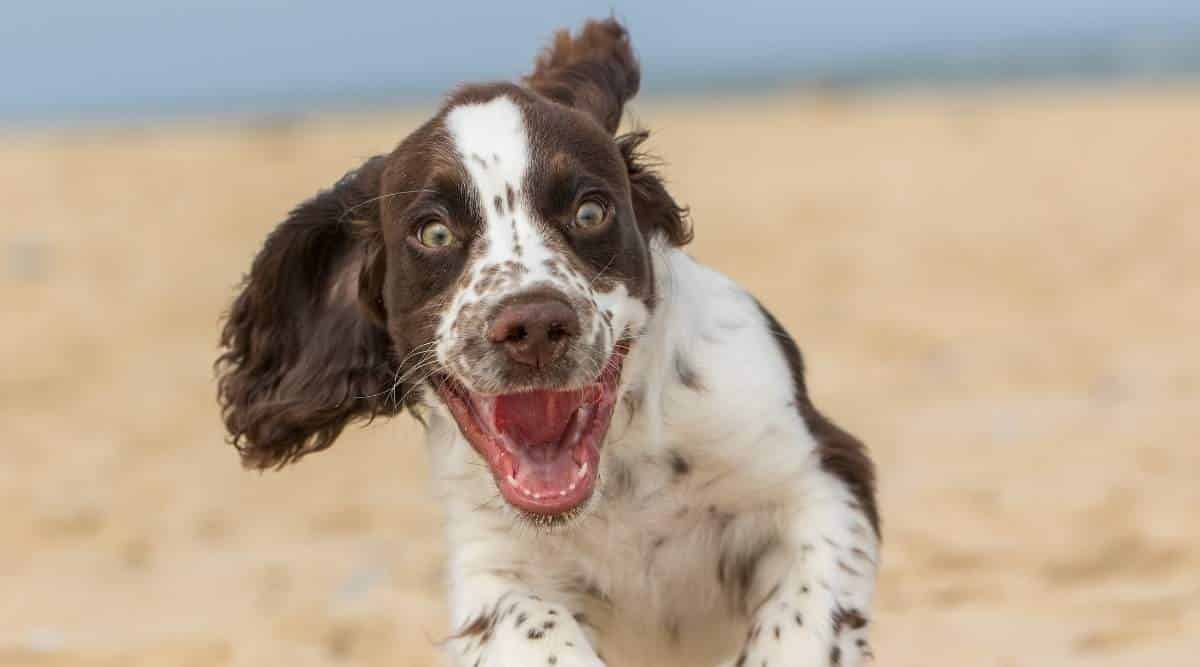Boerboel Dog Breed Information: Facts, Traits, Pictures & More
When you purchase through links on our site, we may earn a commission. Here’s how it works.
Boerboels are powerful, obedient dogs. The breed has roots in South Africa and is well-known farm guardians. They are also well known around the world as the “South African Mastiff.” These dogs are known for being protective, hard-working, and smart, and they make great family companions. Their activities of choice are versatile, from obedience to weight pulling to a therapy dog for small children.
Boerboels require an experienced handler, given their independent, dominant nature. Make sure you can assert control and get your dog to listen. Basic obedience training needs to start young with this breed. You’ll need to make sure you are incentivizing your pup with food, toys, or other positive reinforcement.
Fiercely protective, Boerboels make excellent guard dogs. As a result, they are wary of strangers, so proper introductions when letting people into your home are necessary. Further, given their independent nature, they don’t always do well with other dogs and need to be the only dog in a home. Up for the challenge? If so, you’ll reap the rewards of this incredibly smart, protective breed.
Table of Contents
Breed History

The Boerboel can be traced back to Dutch, German, and Huguenot settlers of South Africa in the mid-1600s. In need of protection, they brought with them bull and mastiff-type dogs. They are often compared to other mastiff breeds to this day.
It’s unclear exactly which breeds make up the genetic history of the breed. Most information out there today is speculation, informed by the breed’s characteristics. That said, it was the strongest breeds who survived the harsh South African climates, and so these ended up proliferating into the breed, giving it its immense strength and fortitude.
Interbreeding these dogs with other European bloodlines in South Africa resulted in the Boer Dog. After some more refinement, the Boerboel was created. These dogs are agile and sturdy, making them perfect for protecting South African farms against large animals such as lions and leopards. They were also used for big-game hunting, with a bite force of up to 800 PSI.
After the World Wars, the Boerboel almost went extinct as a result of unregulated breeding. In the 1980s, the breed made a comeback after enthusiasts put careful, intentional thought into resurrecting the breed.
Although revived in South Africa, the breed has since traveled the globe and became well-loved worldwide. That said, the breed is relatively rare and ranks low on the AKC’s popularity list.
That said, it is misguided to think these dogs are continually looking for a fight. They are incredibly intelligent, as they were bred to protect the family. They know how to distinguish friends from enemies and are highly obedient to those they protect. Their natural state is one of watchfulness, carefully observing their surroundings for danger.
This breed finds success in a versatile amount of activities, from weight-pulling to therapy. They love children. The breed is part of the AKC’s Working Group and was admitted in 2015.
Temperament
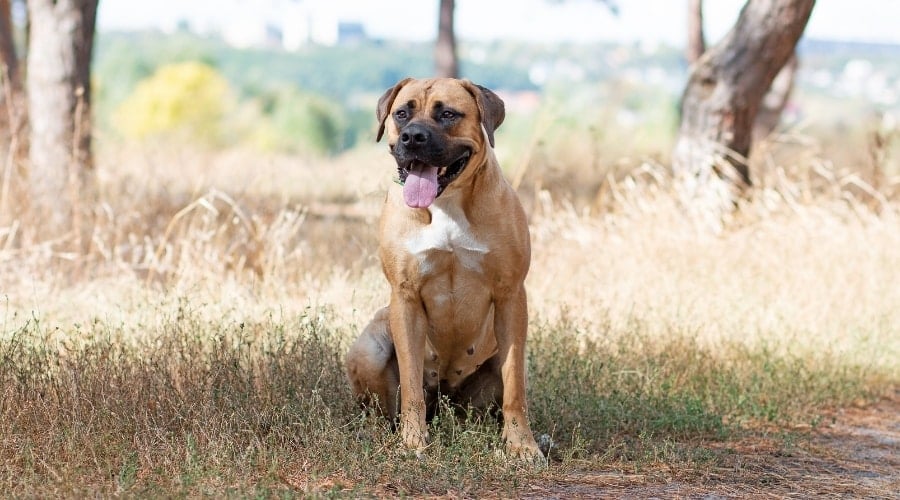
Boerboels are not suited for apartments, given their large size. These dogs need lots of space to roam and protect, ideally with a backyard. Additionally, given its strength, this breed is not meant for first-time owners. They require an experienced handler who can get the best out of the breed.
A dog of this size becomes very dangerous when unruly, so any owner must know how to instill proper manners and obedience. Remember, these are protector dogs. This makes them wary of strangers, so proper and early socialization is critical. They dislike being alone, as they were bred to watch over the family. If you spend most of the day gone, this breed may not be for you.
Given their occupation as therapy dogs, Boerboels love children. They do better with older kids, though, as their size can cause them to knock over smaller kiddos. They do make excellent family companions. If you want, you can even sign your Boerboel up as a therapy dog. When it comes to other dogs, they tend to be standoffish. Early exposure to many different dogs is crucial when it comes to raising a dog-friendly pup. This breed is suited to a one-dog family.
Overall, the Boerboel is obedient, intelligent, and reliable. They are fearless and confident in themselves. That said, be aware that due to their protective nature, these dogs can quickly overtake their owner in an attempt to protect them. To handle the breed, you need to be strong and informed.
Size & Appearance
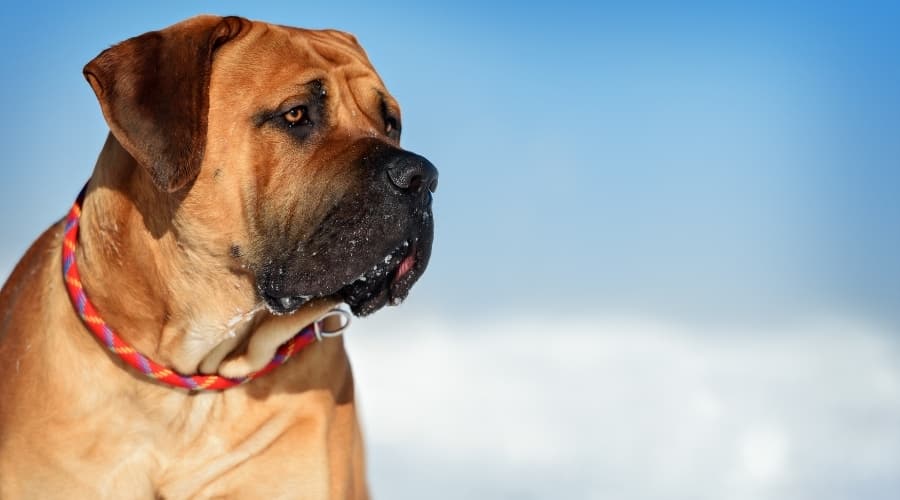
Boerboels are large dogs, weighing 150-200lbs and standing 22-27 inches tall, depending on sex. They appear strong and confident and should display agility and suppleness when moving. They are very muscular and move freely.
Their head is blocky and should display moderate wrinkling in the forehead when the dog is intrigued by something. The muzzle should be broad and narrow as it approaches the nose. It should measure around ⅓ the length of their head. The upper lip is loose, and an underbite should be no more than ¼ inch.
His forelegs are strong and parallel to each other, with no bowing anywhere. From the foreleg to the elbow should measure around 50% of the Boerboel’s height at the shoulder. Front feet should not bow out and should be compact, round, and strongly boned. Toes are to be arched, with short, black toenails.
The hindquarter is sturdy, with the legs being strong-boned. They should allow for intense propulsion when moving, enabling the strength and agility of the breed. All parts of the leg should be muscular, with the thighs being broad and deep. If rear dewclaws exist, they are generally removed.
According to the AKC’s breed guidelines, a dog will not qualify if he has prick ears, blue eyes, a long coat, a nose that is anything but black, or white exceeding greater than 33% of the total dog’s color, and more.
Coat & Colors
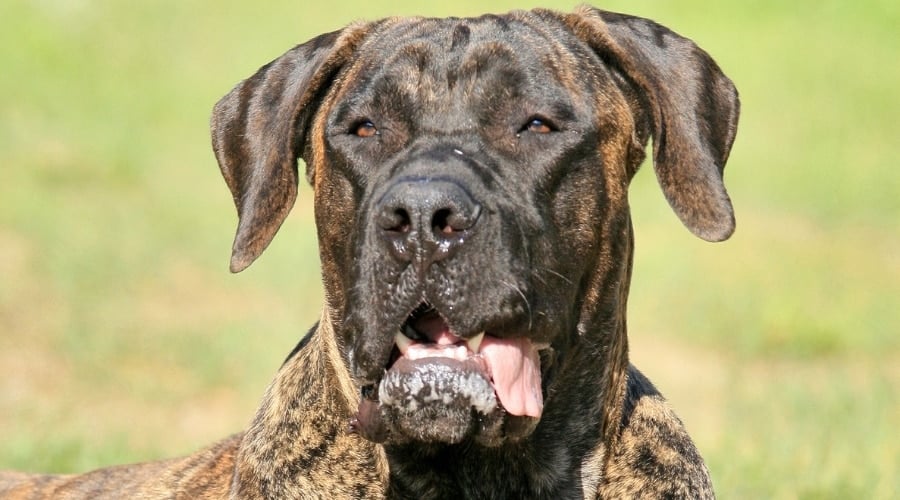
Boerboels have short, straight fur that is smooth and shiny when well-kept. They also have dense, soft undercoats. Breed standard colors include red, fawn, brown, reddish-brown, cream, black, or brindle, and often have spots of white, most likely around the face, paws, and neck. They are double-coated dogs. They are moderate year-round shedders but will shed more in the winter and summer when the weather seasons transition.
Any white on the dog should not exceed 33% of the dog’s total coloring. The dog is well-colored, particularly its skin around the eyes, nose, paw pads, and lips. The skin is loose and thick, but it fits smoothly along the body.
Exercise Needs
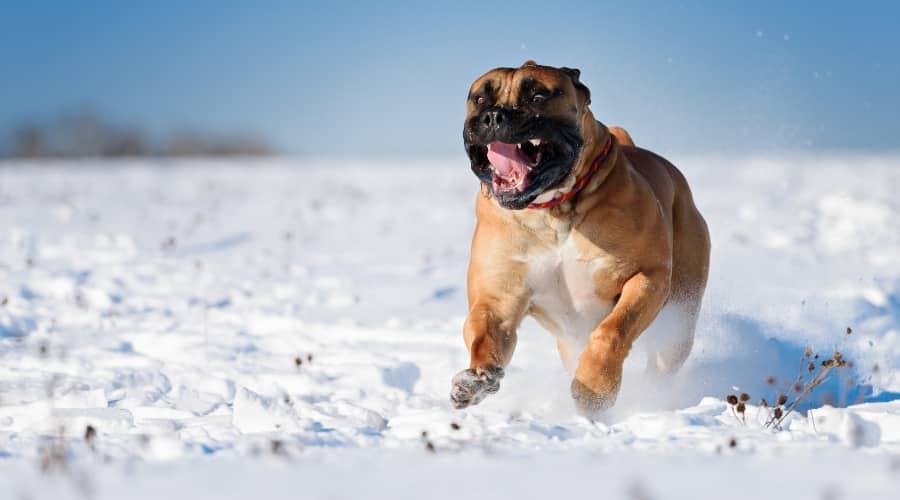
Given their size, Boerboels need daily walks or play sessions where he is securely fenced. It is not recommended that one visits a dog park with this breed, and they should not be let off the leash. Expect to spend between 60-90 minutes exercising this breed each day.
Some great activities include long neighborhood walks, hikes, or a game of ball. In addition to daily exercise, they need mental challenges to keep their mind occupied and sharp. Since the breed is intelligent and has a working drive, this mental stimulation keeps it happy, entertained, and out of trouble. This includes obedience, protection work, or puzzles.
They enjoy weight pull, agility, rally, and obedience competitions; they will also take well to stockwork and protection. Toys are recommended for outdoor play in between walking sessions. Because of their size, consider extra-large dog toys that can withstand some abuse.
Living Requirements
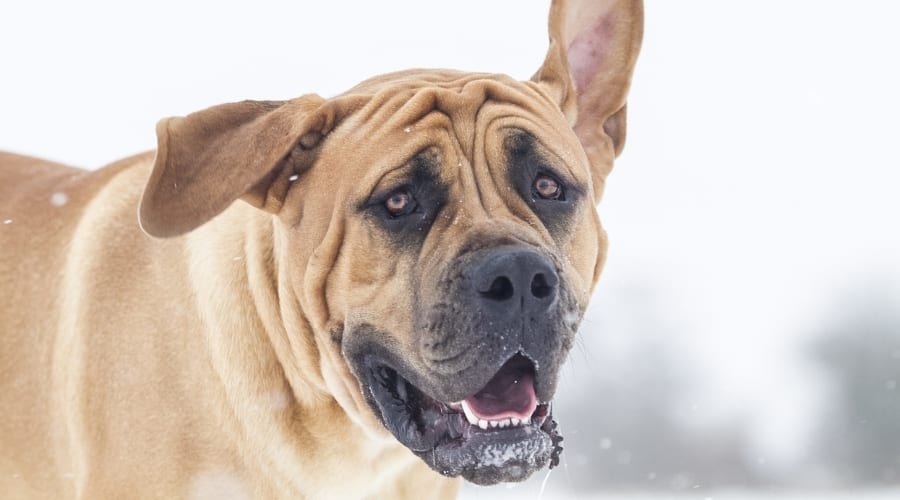
Boerboels do well in large living spaces with fenced-in yards for them to play. Avoid the breed if you live in an apartment or are constantly leaving your dog alone. This breed needs space and attention to be happy. Without it, they can end up being destructive or even dangerous.
If you do live in a large home with a fenced-in yard, consider getting a dog door, so your Boerboel can romp around outside when bored. Additionally, if you’re worried that your dog will cause trouble when left alone, make sure to properly crate-train him so he can be left in his crate when the family leaves. Start young and only use the crate as a positive space where the dog can relax.
Associate the crate with treats, toys, or attention, and start by leaving your pup in there for short periods before increasing it to hours. Never put an anxious or over-excited dog in a crate; only latch the dog in the crate when he is calm. Make sure to get a crate large enough for your dog to stand and turn around in.
Lastly, note that the breed is less tolerant to cold weather and thrives in warm climates, given their South African descent. If you live in a cold, snowy climate, this may not be the best choice.
Training
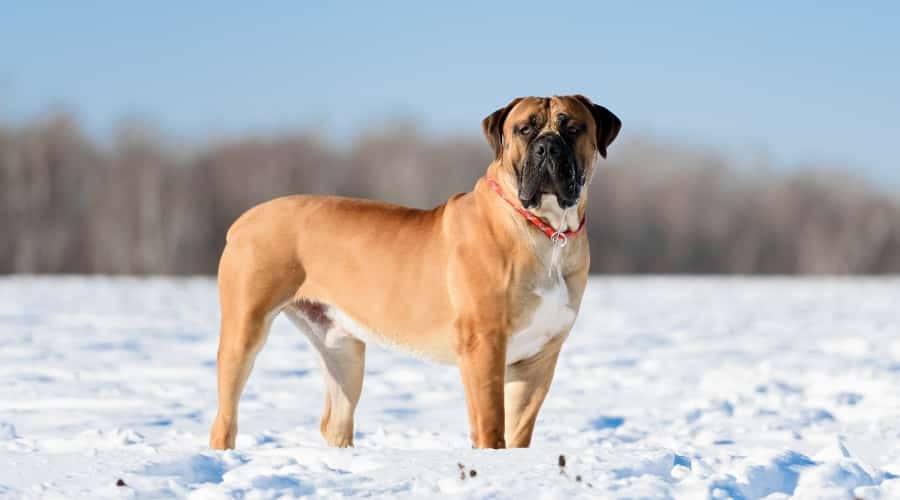
Training a Boerboel is no small feat. These dogs want to dominate, so you need to be firm and assert yourself as the leader. Start with obedience training, and start young, when the dog is 8-10 weeks.
Begin training at home, whether that’s inside or in a more expansive outdoor space. It is not advised that you bring your dog to puppy class or the dog park, as previously discussed.
Firstly, make sure you develop a strong verbal relationship with your dog. If he doesn’t understand your communication, it will be impossible for him to listen to you. This is especially important with an independent dog like a Boerboel, who is already predisposed to wandering off and doing his own thing.
Next, consider demonstrating the task you’re trying to teach. If you want your pup to sit, then sit in front of him. Then associate the movement with a verbal command, ensuring you’re communicating clearly. Of course, practice is the key to success. Regular, daily training sessions of no more than 10-15 minutes will produce the best results.
Practice for as long as it takes for your dog to listen to the command consistently; this can sometimes take a week, depending on the complexity of the command. Keeping your training sessions short will ensure your dog doesn’t get bored or frustrated, which will result in them no longer listening.
As with any dog, having the proper tools for your individual dog is important. Is your Boerboel motivated by food, toys, or affection? Have these on hand, and recognize that not all rewards are equally received.
Health
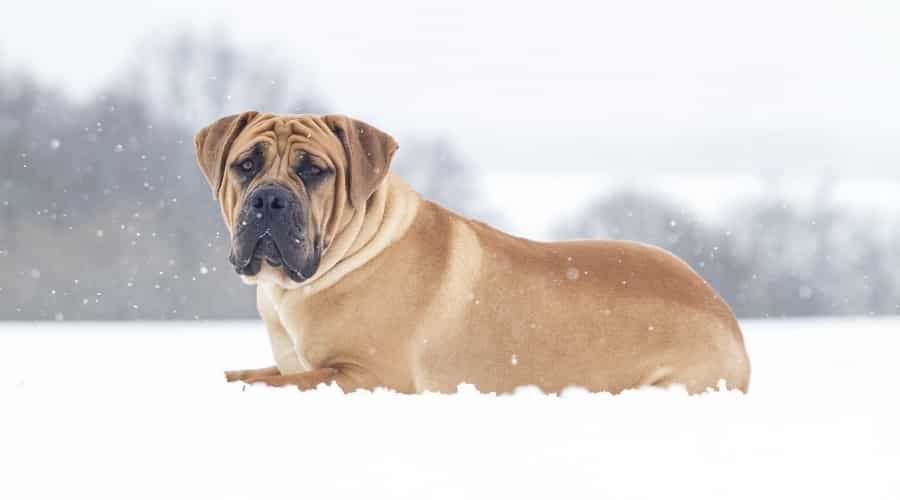
The breed has an average lifespan of 9 to 11 years. As with all dogs, their skin, teeth, ears, and nails should be regularly attended to. Scheduling regular vet checkups and making sure your pup is on a premium dog food will help extend their lifespan. That said, there are some common, more severe health issues to be on the lookout for.
Hip Dysplasia
This occurs when the “hip socket does not fully cover the ball portion of the upper thigh bone.” As a result, the hip can become dislocated. This is common in large dogs and is congenital, so due diligence when picking a breeder can avoid this costly problem.
Additionally, taking basic precautionary steps, such as keeping your dog at a healthy weight and in shape can prevent hip dysplasia from occurring. Importantly, never ask your dog to perform arduous physical tasks, especially those with a lot of impact, until he is fully matured and his skeletal system is fully formed. This prevents damage from occurring. Consider joint supplements like glucosamine if you are nervous.
Elbow Dysplasia
Similarly to hip dysplasia, elbow dysplasia occurs when the elbow joint misforms, causing it to pop out of the socket. This results in pain, soreness, and lameness. The dog’s range of motion will decrease significantly, and the joint may swell. Your Boerboel will likely have difficulty standing up.
In order to diagnose elbow dysplasia, your dog will need to see the vet for x-rays. If diagnosed, treatment depends on severity. In more mild cases, a corrective treatment will suffice; in more severe cases, you may need to opt for surgery.
Heart Disease
This is a common occurrence in many types of dog breeds. Symptoms include intolerance to exercise, coughing, or passing out. Left untreated, all kinds of heart disease can lead to heart failure, which is fatal.
Diagnosing heart disease requires several different appointment types. A physical will pick up any heart murmurs or abnormal blood flow through the heart, whereas an ECG or x-rays are necessary to determine the exact kind of heart disease or if heart failure is present.
Eye Problems
This includes ectropion (droopy eyelids) or entropion (where the eyelids roll inwards). For some breeds, a degree of ectropion is normal, but anything more severe than that will need treatment. Both conditions cause inflammation, and entropion can cause infection or corneal ulcers. These conditions are most commonly hereditary.
Given the congenital nature of most of these disorders, it is very important to verify your Boerboel’s pedigree. Only buy from reputable breeders who do regular health screenings of their breeding dogs, ensuring no hereditary defects are passed down to your puppy.
Nutrition

Given the Boerboel’s size and activity levels, it has particular nutrition needs. Giving your dog a balanced diet will keep him healthy and happy. They need 23-26% protein; start with more protein as a puppy, and progress to slightly less as an adult. 50% carbohydrates, the building blocks for other nutrients. 5.5% fats, serving as the main source of energy. Expect to feed your Boerboel around 5 to 7 cups of high-quality dry kibble per day.
How often per day you feed your dog depends on its age. Younger puppies need to be fed around four times per day. At three months old, reduce feeding to three times per day. At six months of age and beyond, feed twice per day.
Some owners feed their pups a raw diet, meaning completely untouched meats with the bone left in. This essentially means buying uncooked meat, taking it out of the package, and giving it straight to your dog (yes, with the bone in).
The choice is up to you. A raw diet is controversial, with some saying it’s the only diet a dog should ever eat, but it does come at a significantly higher price. Choose the option most feasible for you; no matter what you choose, make sure the diet is high-quality and can support your large breed.
Puppies consume around 580 lbs of dog food per year, whereas adults consume around 610 lbs per year. Feeding a puppy costs, on average, $645 per year, whereas feeding an adult Boerboel costs, on average, $555, as high as $945 per year.
Grooming
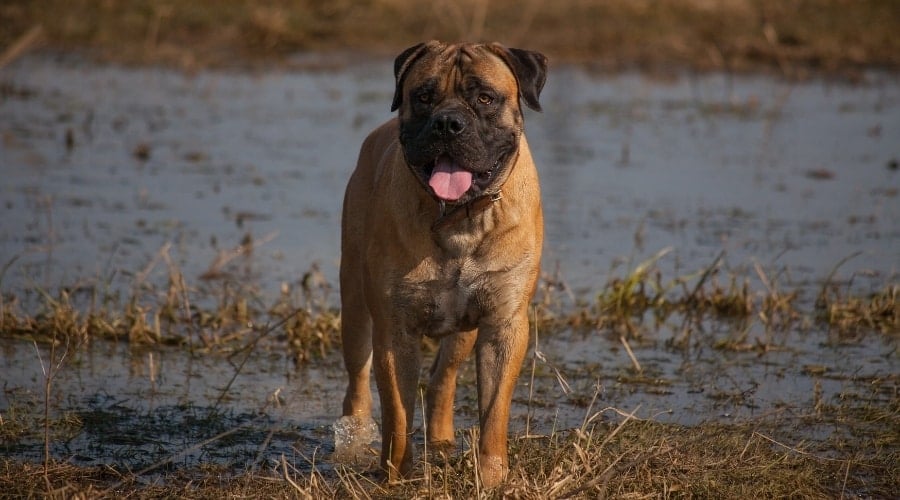
Since their coat is short, Boerboels do not need extensive grooming. Weekly brushing with a grooming mitt or soft-bristle brush helps keep your dog looking great. Brushing also distributes skin oils across the body and promotes hair growth.
Take notice of any sensitive areas, and ensure you’re being gentle when brushing those areas. During regular grooming, inspect your dog for fleas and parasites. They need baths only on occasion. Keep the water lukewarm and dry your dog off with towels when done. Never use hair dryers made for humans, as those are far too hot for dogs.
Boerboels’ nails need to be trimmed, less so if they play on hard surfaces that will naturally grind nails. Their ears should also be regularly inspected to prevent infection. Make sure to clean your dog’s teeth using either toothbrushes or finger sleeves. Your dog’s teeth will stay whiter if fed a raw diet, but regular dental inspections are still important.
Breeders & Puppy Costs
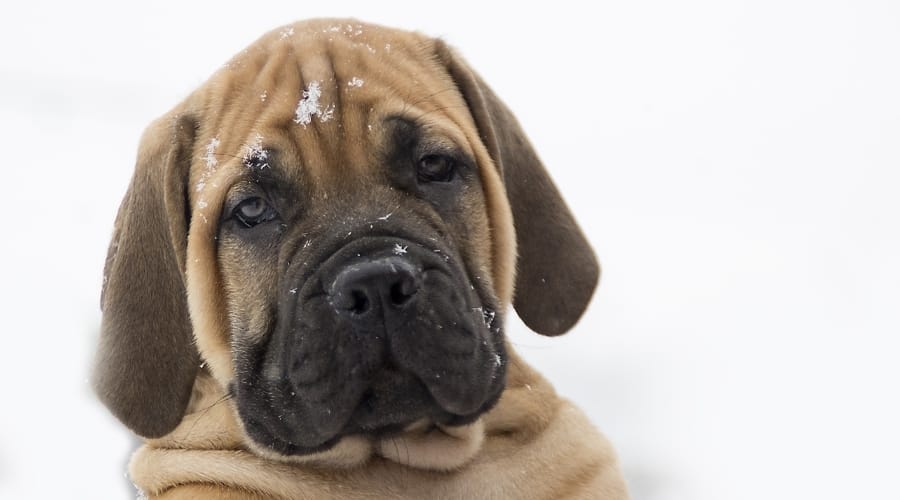
Since the Boerboel is registered with the AKC, it’s best to start with their registry. The AKC holds breeders to an extremely high standard, ensuring they produce top-quality, healthy dogs. This helps avoid any costly, painful congenital issues mentioned previously, such as hip or elbow dysplasia.
Although the AKC does the vetting for you, there are certain factors to look for when choosing a breeder. Do they have health screening paperwork on all their breeding dogs, proving that their dogs bear no congenital issues? Are their facilities spacious and clean? What do their clients say about them? Do they allow pups to go home before 8 weeks? Do they require a post-purchase exam within 72 hours? Basic due diligence can only help.
Purebred puppies cost between $1,200 and $2,500, with an average price of $2,000.
Rescues & Shelters
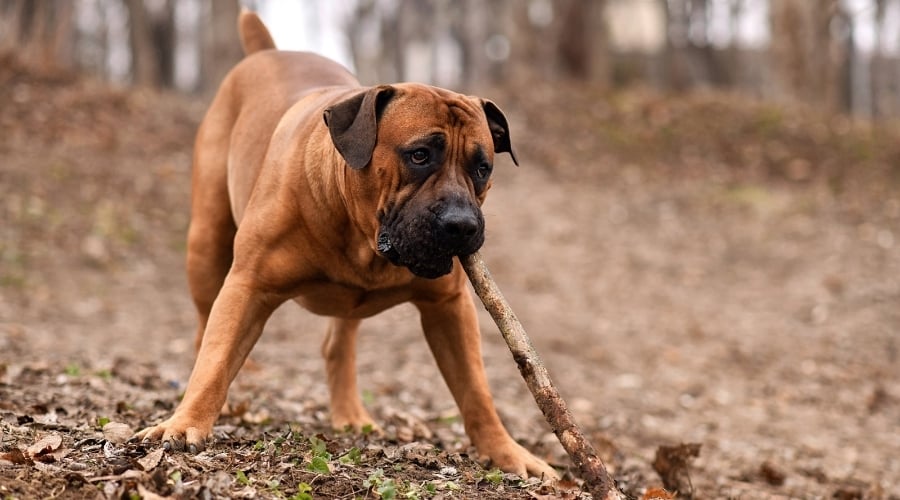
We recommend looking to adopt a dog before purchasing a puppy. Around 670,000 dogs are euthanized each year in shelters because they have no place to go, so opening your home to a second-hand Boerboel is doing a great service.
That said, since it’s an uncommon breed, finding rescues dedicated to it is challenging. Giant Paws Boerboel Rescue is the most prominent. Another option is to look at Mastiff rescues, as the breed is a type of Mastiff and may appear in these organizations.
Here are some Mastiff rescues:
One great benefit to rescuing an adult Boerboel is that you avoid the cost and headache of raising a puppy. First-year puppies can cost upwards of $1,500 (not including the initial purchase price) in that initial year alone, and a puppy involves potty training, crate training, teaching him not to chew your cords and shoes, and so on.
As Family Pets
- They originate from South Africa do better in a warm climate.
- The Boerboel is energetic and requires daily exercise.
- These dogs are massive, active dogs.
- They are not suited for apartment living.
- This breed can be challenging to train and need an experienced owner.
- Once properly socialized, they are excellent family companions.
- This is a working breed, and they enjoy agility, obedience, and protective work.
- Typically, the breed does best when they are only dogs.
- Consider another breed if you already have a multi-pet household.
- We recommend avoiding the dog park if your pup has not been socialized early on.
Final Thoughts
Boerboels are active, smart, protective dogs who make great family companions. They are not suited for first-time dog owners, as they can be difficult to train and can be dangerous when they become unruly. These dogs need to be the only pup in a household, given their protective nature. They do not do well around other dogs or strangers, so introduce other dogs and people correctly.
Given their size, this breed needs lots of space. Do not get this breed if you live in an apartment. These dogs require daily, vigorous exercise and enjoy long walks, hikes, and an intense game of fetch.
Start training at a young age, as early as 8 to 10 weeks, emphasizing basic obedience. Assert yourself as the leader, as this breed likes to take control. You can also train your dog to do agility, protective work, weight pulling, and so on. Any activity that stimulates the mind and body will make a Boerboel very happy. For the right owner, this breed makes an exceptional companion.



